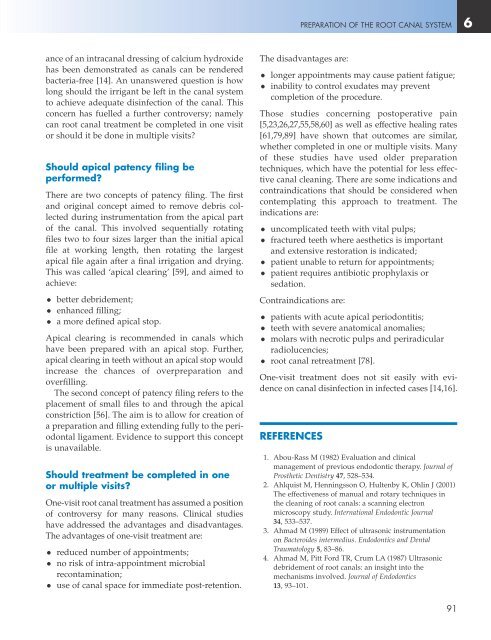Preparation of RC System---9780723610892
You also want an ePaper? Increase the reach of your titles
YUMPU automatically turns print PDFs into web optimized ePapers that Google loves.
PREPARATION OF THE ROOT CANAL SYSTEM 6<br />
ance <strong>of</strong> an intracanal dressing <strong>of</strong> calcium hydroxide<br />
has been demonstrated as canals can be rendered<br />
bacteria-free [14]. An unanswered question is how<br />
long should the irrigant be left in the canal system<br />
to achieve adequate disinfection <strong>of</strong> the canal. This<br />
concern has fuelled a further controversy; namely<br />
can root canal treatment be completed in one visit<br />
or should it be done in multiple visits?<br />
Should apical patency filing be<br />
performed?<br />
There are two concepts <strong>of</strong> patency filing. The first<br />
and original concept aimed to remove debris collected<br />
during instrumentation from the apical part<br />
<strong>of</strong> the canal. This involved sequentially rotating<br />
files two to four sizes larger than the initial apical<br />
file at working length, then rotating the largest<br />
apical file again after a final irrigation and drying.<br />
This was called ‘apical clearing’ [59], and aimed to<br />
achieve:<br />
• better debridement;<br />
• enhanced filling;<br />
• a more defined apical stop.<br />
Apical clearing is recommended in canals which<br />
have been prepared with an apical stop. Further,<br />
apical clearing in teeth without an apical stop would<br />
increase the chances <strong>of</strong> overpreparation and<br />
overfilling.<br />
The second concept <strong>of</strong> patency filing refers to the<br />
placement <strong>of</strong> small files to and through the apical<br />
constriction [56]. The aim is to allow for creation <strong>of</strong><br />
a preparation and filling extending fully to the periodontal<br />
ligament. Evidence to support this concept<br />
is unavailable.<br />
Should treatment be completed in one<br />
or multiple visits?<br />
One-visit root canal treatment has assumed a position<br />
<strong>of</strong> controversy for many reasons. Clinical studies<br />
have addressed the advantages and disadvantages.<br />
The advantages <strong>of</strong> one-visit treatment are:<br />
• reduced number <strong>of</strong> appointments;<br />
• no risk <strong>of</strong> intra-appointment microbial<br />
recontamination;<br />
• use <strong>of</strong> canal space for immediate post-retention.<br />
The disadvantages are:<br />
• longer appointments may cause patient fatigue;<br />
• inability to control exudates may prevent<br />
completion <strong>of</strong> the procedure.<br />
Those studies concerning postoperative pain<br />
[5,23,26,27,55,58,60] as well as effective healing rates<br />
[61,79,89] have shown that outcomes are similar,<br />
whether completed in one or multiple visits. Many<br />
<strong>of</strong> these studies have used older preparation<br />
techniques, which have the potential for less effective<br />
canal cleaning. There are some indications and<br />
contraindications that should be considered when<br />
contemplating this approach to treatment. The<br />
indications are:<br />
• uncomplicated teeth with vital pulps;<br />
• fractured teeth where aesthetics is important<br />
and extensive restoration is indicated;<br />
• patient unable to return for appointments;<br />
• patient requires antibiotic prophylaxis or<br />
sedation.<br />
Contraindications are:<br />
• patients with acute apical periodontitis;<br />
• teeth with severe anatomical anomalies;<br />
• molars with necrotic pulps and periradicular<br />
radiolucencies;<br />
• root canal retreatment [78].<br />
One-visit treatment does not sit easily with evidence<br />
on canal disinfection in infected cases [14,16].<br />
REFERENCES<br />
1. Abou-Rass M (1982) Evaluation and clinical<br />
management <strong>of</strong> previous endodontic therapy. Journal <strong>of</strong><br />
Prosthetic Dentistry 47, 528–534.<br />
2. Ahlquist M, Henningsson O, Hultenby K, Ohlin J (2001)<br />
The effectiveness <strong>of</strong> manual and rotary techniques in<br />
the cleaning <strong>of</strong> root canals: a scanning electron<br />
microscopy study. International Endodontic Journal<br />
34, 533–537.<br />
3. Ahmad M (1989) Effect <strong>of</strong> ultrasonic instrumentation<br />
on Bacteroides intermedius. Endodontics and Dental<br />
Traumatology 5, 83–86.<br />
4. Ahmad M, Pitt Ford TR, Crum LA (1987) Ultrasonic<br />
debridement <strong>of</strong> root canals: an insight into the<br />
mechanisms involved. Journal <strong>of</strong> Endodontics<br />
13, 93–101.<br />
91



